Root
Phylogenetically, the root arose later than the stem and leaf - in connection with the transition of plants to life on land and probably originated from root-like underground branches. The root has no leaves or buds arranged in a certain order. It is characterized by apical growth in length, its lateral ramifications arise from internal tissues, the growth point is covered with a root cap. The root system is formed throughout the life of a plant organism. Sometimes the root can serve as a place of deposition in the supply of nutrients. In this case, it is modified.
Root types
The main root is formed from the embryonic root when the seed germinates. Lateral roots extend from it.
Adventitious roots develop on stems and leaves.
Lateral roots are branches of any root.
Each root (main, lateral, adventitious) has the ability to branch, which significantly increases the surface of the root system, and this contributes to better strengthening of the plant in the soil and improving its nutrition.
Types of root systems
There are two main types of root systems: pivotal, with a well-developed main root, and fibrous. The fibrous root system consists of a large number of adventitious roots of the same size. The entire mass of roots consists of lateral or adventitious roots and looks like a lobe.
The highly branched root system forms a huge absorbing surface. For example,
- the total length of the roots of winter rye reaches 600 km;
- length of root hairs - 10,000 km;
- total root surface - 200 m 2.
This is many times the area of the above-ground mass.
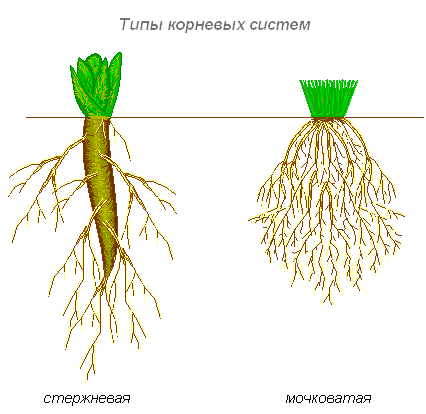
If the plant has a well-defined main root and adventitious roots develop, then a mixed root system is formed (cabbage, tomato).
External structure of the root. Internal structure of the root
Root zones
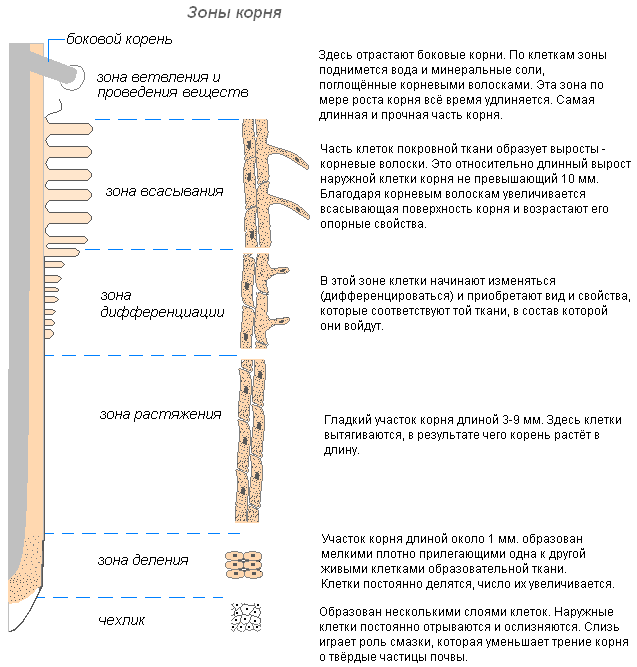
Root cap
The root grows in length at its tip, where young cells of the educational tissue are located. The growing part is covered with a root cap that protects the root tip from damage and makes it easier for the root to move through the soil during growth. The latter function is carried out due to the property of the outer walls of the root cap to be covered with mucus, which reduces friction between the root and soil particles. They can even push apart soil particles. The cells of the root cap are alive and often contain starch grains. The cells of the cap are constantly renewed due to division. Participates in positive geotropic reactions (direction of root growth towards the center of the Earth).
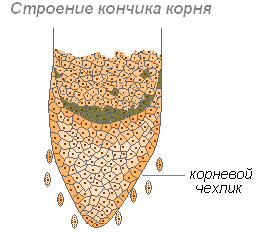
The cells of the division zone are actively dividing; the length of this zone is not the same in different species and in different roots of the same plant.
A stretch zone (growth zone) is located behind the division zone. The length of this zone does not exceed a few millimeters.
As the linear growth is completed, the third stage of root formation begins - its differentiation, a zone of differentiation and specialization of cells (or a zone of root hairs and absorption) is formed. In this zone, the outer layer of the epiblema (rhizoderm) with root hairs, the layer of the primary cortex and the central cylinder are already distinguished.
Root hair structure
Root hairs are highly elongated outgrowths of the outer cells that cover the root. The number of root hairs is very large (per 1 mm 2 from 200 to 300 hairs). Their length reaches 10 mm. Hair is formed very quickly (in young apple seedlings in 30-40 hours). Root hairs are short-lived. They die off after 10-20 days, and new ones grow on the young part of the root. This ensures the development of new soil horizons by the root. The root grows continuously, forming more and more new areas of root hairs. The hairs can not only absorb ready-made solutions of substances, but also help dissolve some soil substances, and then suck them in. The area of the root, where the root hairs have died off, is able to absorb water for some time, but then it becomes covered with a cork and loses this ability.
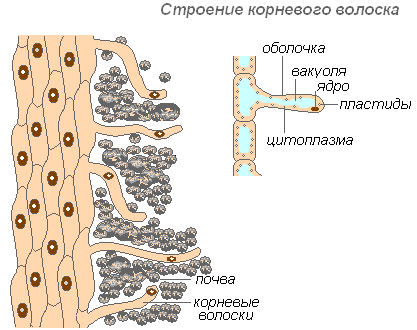
The hair sheath is very thin, which facilitates the absorption of nutrients. Almost the entire hair cell is occupied by a vacuole surrounded by a thin layer of cytoplasm. The nucleus is at the top of the cell. A mucous sheath is formed around the cell, which promotes adhesion of root hairs with soil particles, which improves their contact and increases the hydrophilicity of the system. The absorption is promoted by the release of acids (carbonic, malic, citric) by the root hairs, which dissolve mineral salts.
Root hairs also play a mechanical role - they serve as a support for the root apex, which passes between soil particles.
Under the microscope, on a transverse section of the root in the absorption zone, its structure at the cellular and tissue levels is visible. On the surface of the root is the rhizoderm, below it is the bark. The outer layer of the cortex is the exoderm, inward from it is the main parenchyma. Its thin-walled living cells perform a storage function, carry out solutions of nutrients in a radial direction - from the suction tissue to the vessels of the wood. They also synthesize a number of organic substances vital for the plant. The inner layer of the cortex is endoderm. Nutrient solutions from the cortex into the central cylinder through the endoderm cells pass only through the protoplast of the cells.

The bark surrounds the central cylinder of the root. It borders on a layer of cells that retain their ability to divide for a long time. This is the pericycle. Pericycle cells give rise to lateral roots, accessory buds and secondary educational tissues. Inward from the pericycle, in the center of the root, are the conductive tissues: bast and wood. Together they form a radial conductive bundle.
The root conduction system conducts water and minerals from the root to the stem (upward current) and organic matter from the stem to the root (downward current). It consists of vascular fibrous bundles. The main components of the bundle are sections of the phloem (along which substances move to the root) and xylem (along which substances move from the root). The main conducting elements of phloem are sieve tubes, xylems are trachea (vessels) and tracheids.
Root vital processes
Root water transport
Absorption of water by root hairs from the soil nutrient solution and carrying it in the radial direction along the cells of the primary cortex through the passage cells in the endoderm to the xylem of the radial conducting bundle. The intensity of water absorption by root hairs is called the suction force (S), it is equal to the difference between osmotic (P) and turgor (T) pressure: S = P-T.
When the osmotic pressure is equal to the turgor pressure (P = T), then S = 0, water stops flowing into the cell of the root hair. If the concentration of substances in the soil nutrient solution is higher than inside the cell, then the water will leave the cells and plasmolysis will occur - the plants will wither. This phenomenon is observed under conditions of dry soil, as well as with excessive application of mineral fertilizers. Inside the root cells, the sucking force of the root increases from the rhizoderm towards the central cylinder, so the water moves along the concentration gradient (i.e., from a place with its higher concentration to a place with a lower concentration) and creates root pressure, which raises the water column along the xylem vessels forming an upward current. This can be found on leafless spring trunks when the "sap" is collected, or on cut tree stumps. The outflow of water from wood, fresh stumps, leaves is called "crying" of plants. When the leaves bloom, they also create a sucking force and attract water to themselves - a continuous column of water is formed in each vessel - capillary tension. The root pressure is the lower motor of the water current, and the sucking force of the leaves is the upper one. This can be confirmed with the help of simple experiments.
Absorption of water by the roots
Target: figure out the basic function of the root.
What do we do: a plant grown on wet sawdust, shake off its root system and put its roots in a glass of water. Pour a thin layer of vegetable oil on top of the water to protect it from evaporation and mark the level.
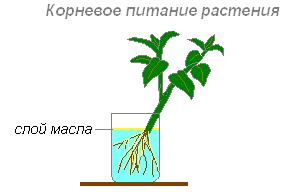
What we observe: in a day or two, the water in the container dropped below the mark.

Result: therefore, the roots sucked in the water and brought it up to the leaves.
One more experiment can be done to prove the absorption of nutrients by the root.
What do we do: Cut off the stem of the plant, leaving a stump 2-3 cm high.Place a rubber tube 3 cm long on the stump, and put a curved glass tube 20-25 cm high on the upper end.
What we observe: the water in the glass tube rises and flows out.
Result: this proves that the root absorbs water from the soil into the stem.
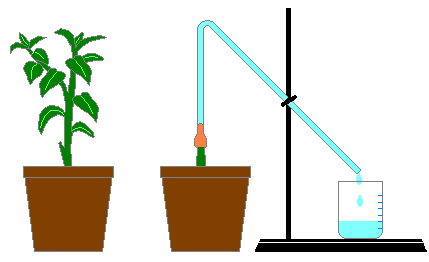
Does the water temperature affect the rate of water absorption by the root?
Target: find out how temperature affects the work of the root.
What do we do: one glass should be with warm water (+ 17-18 ° C), and the other with cold (+ 1-2 ° C).
What we observe: in the first case, the water is released abundantly, in the second - little, or completely stops.
Result: this is proof that temperature has a profound effect on the functioning of the root.
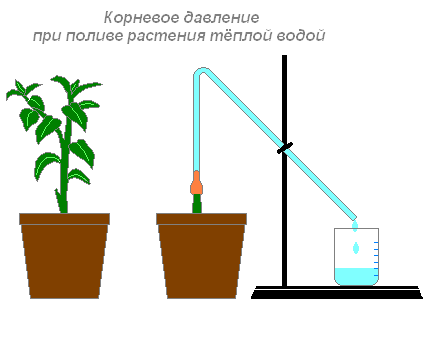
Warm water is actively absorbed by the roots. Root pressure rises.

Cold water is poorly absorbed by the roots. In this case, the root pressure drops.
Mineral nutrition
The physiological role of minerals is very important. They are the basis for the synthesis of organic compounds, as well as factors that change the physical state of colloids, i.e. directly affect the metabolism and structure of the protoplast; serve as catalysts for biochemical reactions; affect cell turgor and protoplasm permeability; are the centers of electrical and radioactive phenomena in plant organisms.
It has been established that the normal development of plants is possible only if the nutrient solution contains three non-metals - nitrogen, phosphorus and sulfur and - and four metals - potassium, magnesium, calcium and iron. Each of these elements has an individual meaning and cannot be replaced by another. These are macronutrients, their concentration in the plant is 10 -2 –10%. For the normal development of plants, microelements are needed, the concentration of which in the cell is 10 -5 -10 -3%. These are boron, cobalt, copper, zinc, manganese, molybdenum, etc. All these elements are present in the soil, but sometimes in insufficient quantities. Therefore, mineral and organic fertilizers are applied to the soil.
The plant grows and develops normally if all the necessary nutrients are contained in the environment surrounding the roots. Soil is such a medium for most plants.
Breathing roots
For normal growth and development of the plant, it is necessary that fresh air flows to the root. Let's check if this is so?
Target: does the root need air?
What do we do: take two identical vessels with water. We will place developing seedlings in each vessel. We saturate the water in one of the vessels with air every day using a spray bottle. Pour a thin layer of vegetable oil on the surface of the water in the second vessel, as it delays the flow of air into the water.
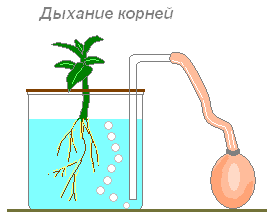
What we observe: after a while, the plant in the second vessel will stop growing, wither, and eventually die.
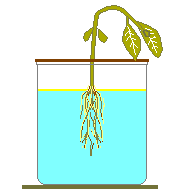
Result: the death of the plant occurs due to the lack of air necessary for the respiration of the root.
Root modifications
Some plants store reserve nutrients in the roots. They accumulate carbohydrates, mineral salts, vitamins and other substances. Such roots grow strongly in thickness and acquire an unusual appearance. Both the root and the stem are involved in the formation of root crops.
Roots
If storage substances accumulate in the main root and at the base of the stem of the main shoot, root crops (carrots) are formed. Root-forming plants are mainly biennials. In the first year of life, they do not bloom and accumulate many nutrients in root crops. On the second, they bloom quickly, using the accumulated nutrients and form fruits and seeds.
Root tubers
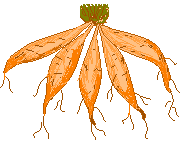
In dahlia, reserve substances accumulate in the adventitious roots, forming root tubers.
Bacterial nodules
The lateral roots of clover, lupine, and alfalfa are peculiarly changed. Bacteria settle in the young lateral roots, which facilitates the assimilation of gaseous nitrogen in the soil air. Such roots take the form of nodules. Thanks to these bacteria, these plants are able to live in nitrogen-poor soils and make them more fertile.
Stilted
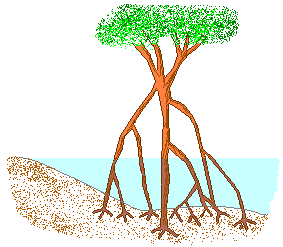
A ramp growing in an ebb-tide zone develops stilted roots. They hold large leafy shoots high above the water on unsteady muddy ground.
Air
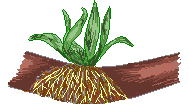
Tropical plants living on tree branches develop aerial roots. They are often found in orchids, bromeliads, and some ferns. Aerial roots hang freely in the air, not reaching the ground and absorbing moisture that falls on them from rain or dew.
Retracting
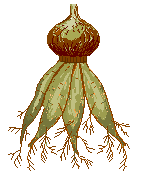
In bulbous and corms, such as crocuses, among the numerous filamentous roots, there are several thicker, so-called retracting roots. Shrinking, such roots pull the corms deeper into the soil.
Columnar

The ficus develops columnar aerial roots, or support roots.
Soil as a habitat for roots
The soil for plants is the medium from which it receives water and nutrients. The amount of mineral substances in the soil depends on the specific characteristics of the parent rock, the activity of organisms, on the life of the plants themselves, on the type of soil.
Soil particles compete with the roots for moisture, retaining it on their surface. This is the so-called bound water, which is subdivided into hygroscopic and film water. It is held by the forces of molecular attraction. The moisture available to the plant is represented by capillary water, which is concentrated in the small pores of the soil.
Antagonistic relations develop between the moisture and the air phase of the soil. The more large pores in the soil, the better the gas regime of these soils, the less moisture the soil retains. The most favorable water-air regime is maintained in structural soils, where water and air are located simultaneously and do not interfere with each other - water fills capillaries inside structural aggregates, and air fills large pores between them.
The nature of the interaction between the plant and the soil is largely related to the absorption capacity of the soil - the ability to retain or bind chemical compounds.
Soil microflora decomposes organic matter to simpler compounds, participates in the formation of the soil structure. The nature of these processes depends on the type of soil, the chemical composition of plant residues, the physiological properties of microorganisms, and other factors. Soil animals take part in the formation of the soil structure: annelids, insect larvae, etc.
As a result of the combination of biological and chemical processes in the soil, a complex complex of organic substances is formed, which is united by the term "humus".
Aquatic culture method
What salts the plant needs, and what effect they have on its growth and development, has been established by experiment with aquatic crops. The aquatic culture method is the cultivation of plants not in soil, but in an aqueous solution of mineral salts. Depending on the goal in the experiment, you can exclude an individual salt from the solution, reduce or increase its content. It was found that fertilizers containing nitrogen promote the growth of plants containing phosphorus - the early ripening of fruits, and those containing potassium - the fastest outflow of organic matter from the leaves to the roots. In this regard, fertilizers containing nitrogen are recommended to be applied before sowing or in the first half of summer, containing phosphorus and potassium - in the second half of summer.
Using the method of aquatic cultures, it was possible to establish not only the plant's need for macronutrients, but also to clarify the role of various trace elements.
Currently, there are cases when plants are grown using hydroponics and aeroponics.
Hydroponics - growing plants in containers filled with gravel. The nutrient solution containing the necessary elements is fed into the vessels from the bottom.
Aeroponics is an aerial plant culture. With this method, the root system is in the air and is automatically (several times within an hour) sprayed with a weak solution of nutrient salts.







